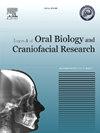Antibacterial activity of 1 % Roselle flower nano-emulsion extract (Hibiscus sabdariffa) against peri-implantitis-related bacteria on orthodontic mini-implants: An in vitro study
Q1 Medicine
Journal of oral biology and craniofacial research
Pub Date : 2025-01-01
DOI:10.1016/j.jobcr.2024.12.017
引用次数: 0
Abstract
Objective
The orthodontic mini-implant (OMI) failure often occurs due to the accumulation of peri-implantitis bacteria surrounding it, which results in a stable, resistant form of absolute skeletal anchorage during orthodontic treatment. Administering doxycycline may be the solution, but long-term side effects result in antibiotic resistance. Roselle flowers (Hibiscus sabdariffa) possess beneficial active phytochemical substances, which may have potential as an OMI peri-implantitis alternative therapy. This study investigates the antibacterial activity of 1 % Roselle flower (H. sabdarifa) nanoemulsion (NE) extract (1 % RNE) toward peri-implantitis bacteria in OMIs.
Methods
A phytochemical analysis of 1 % RNE was carried out to examine the active substances possessed in it, such as flavonoids, quinone, saponin, alkaloids, tannins, terpenoids, and steroids. Nanoemulsion characterization was carried out using a particle size analyzer (PSA). The antibacterial activity of 1 % RNE toward Prevotella intermedia (Pi), Porphyromonas gingivalis (Pg), Aggregatibacter actinomycetemcomitans (Aa), and Fusobacterium nucleatum (Fn) was carried out to determine the minimum inhibitory concentration, minimum bactericidal concentration, and inhibitory zone compared with doxycycline as a positive control.
Results
Roselle flower NE extract (1 %) possessed flavonoids, quinone, saponin, alkaloids, tannins, terpenoids, and steroids positively. The PSA showed that the 1 % RNE had a size of 98.13 d nm. The antibacterial activity of 1 % RNE against Aa, Pg, Pi, and Fn bacteria at 3.125 % showed significant differences (p < 0.05). The antibacterial activity of 1 % RNE toward peri-implantitis bacteria is lower than that of doxycycline.
Conclusion
Roselle flower NE extract (1 %) has antibacterial activity against peri-implantitis bacteria at a concentration of 3.125 %.

1%玫瑰花纳米乳剂提取物(芙蓉)对正畸微型种植体种植周相关细菌的抑菌活性:体外研究
目的:在正畸治疗过程中,由于种植体周围细菌的积累,导致迷你种植体(OMI)失败,导致绝对骨支抗不稳定。给予强力霉素可能是解决方案,但长期的副作用会导致抗生素耐药性。玫瑰花(Hibiscus sabdariffa)含有有益的活性植物化学物质,可能有潜力作为OMI种植体周围炎的替代疗法。研究了1%玫瑰花(H. sabdarifa)纳米乳(NE)提取物(1% RNE)对OMIs种植体周围细菌的抑菌活性。方法:对1% RNE进行植物化学分析,检测其活性物质黄酮类、醌类、皂苷类、生物碱类、单宁类、萜类、甾体等。采用粒径分析仪(PSA)对纳米乳进行了表征。以1% RNE对中间普氏菌(Pi)、牙龈卟啉单胞菌(Pg)、放线菌聚集菌(Aa)和核梭杆菌(Fn)的抑菌活性为对照,确定其最小抑菌浓度、最小杀菌浓度和抑菌区。结果:玫瑰花NE提取物(1%)中含有黄酮类、醌类、皂苷类、生物碱类、单宁类、萜类和甾类化合物。PSA显示1% RNE的大小为98.13 d nm。在3.125%浓度下,1%龙舌兰提取物对Aa、Pg、Pi和Fn细菌的抑菌活性差异有统计学意义(p)。结论:1%龙舌兰提取物对3.125%浓度下种植体周围细菌具有抑菌活性。
本文章由计算机程序翻译,如有差异,请以英文原文为准。
求助全文
约1分钟内获得全文
求助全文
来源期刊

Journal of oral biology and craniofacial research
Medicine-Otorhinolaryngology
CiteScore
4.90
自引率
0.00%
发文量
133
审稿时长
167 days
期刊介绍:
Journal of Oral Biology and Craniofacial Research (JOBCR)is the official journal of the Craniofacial Research Foundation (CRF). The journal aims to provide a common platform for both clinical and translational research and to promote interdisciplinary sciences in craniofacial region. JOBCR publishes content that includes diseases, injuries and defects in the head, neck, face, jaws and the hard and soft tissues of the mouth and jaws and face region; diagnosis and medical management of diseases specific to the orofacial tissues and of oral manifestations of systemic diseases; studies on identifying populations at risk of oral disease or in need of specific care, and comparing regional, environmental, social, and access similarities and differences in dental care between populations; diseases of the mouth and related structures like salivary glands, temporomandibular joints, facial muscles and perioral skin; biomedical engineering, tissue engineering and stem cells. The journal publishes reviews, commentaries, peer-reviewed original research articles, short communication, and case reports.
 求助内容:
求助内容: 应助结果提醒方式:
应助结果提醒方式:


